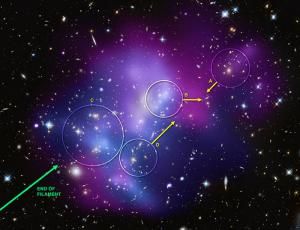Earlier this year, FQXi bloggers (and Perimeter Institute cosmologists) Niayesh Afshordi and Mark Wyman reviewed our current understanding (or confusion) over the nature of dark matter (Niayesh blogged here, while Mark's take is here). They were both excited by a series of tantalising experimental results that suggested that an excess of positrons created by dark matter interactions had been spotted. In March, FQXi's Renata Kallosh also hinted that new dark matter results were imminent and now, it seems, they are here.

Fermi telescope
At the APS conference, over the weekend, Peter Michelson announced the first results pertaining to the (dark) matter from the Fermi gamma ray telescope. So, are we seeing the signature of dark matter or not? The answer seems to be a resounding, erm, *maybe*.
Fermi does see high energy electrons and positrons with greater accuracy than the PAMELA experiment did. It could be that excess was created by dark matter annihilation or by dark matter decay. But it could also be produced by pulsars. So they still can't say exactly what's going on. (For more technical details, I'll refer you to Cosmic Variance or Symmetry Breaking.)
So how can we distinguish between dark and light (that is, pulsar) culprits? Fermi will look at gamma rays, which could be produced by either pulsars or the decay of dark matter particles. Gamma rays aren't charged and so they won't be deflected by galactic fields as they travel towards us. That means we could potentially trace them back to their source. Pulsar sources should lie along the plane of the Milky Way, while dark matter would be more uniformly distributed.
That said, this kind of tracing game can be tricky. Two years ago the Pierre Auger Observatory in Argentina announced that it had solved the mystery of the origin of high energy cosmic rays, stating that they are produced by supermassive black holes. But Eric Hand, blogging for Nature from the APS, notes that having accumulated more data, the team are now backing off that claim.

Cosmic Web
Getting back to dark matter, the exotic stuff seems to be having mixed fortunes elsewhere this week. "Study Plunges Standard Theory of Cosmology into Crisis" screams phys.org. (Following a week where the news has been dominated by swine flu panic, I can see why they might need dramatic headlines to get attention.) The piece claims that recent work appearing in the Astrophysical Journal and MNRAS examining the position and motion of dwarf galaxies around the Milky Way may favour theories in which our understanding of gravity needs to be tweaked from its standard form (MOND theories) over more conventional dark matter pictures. Meanwhile, another paper appearing in Astrophysical Journal Letters suggests, in contrast, that gas flowing along filaments of dark matter has been spotted for the first time (nicely explained in that link by New Scientist's Maggie McKee) creating a cosmic spider's web.
So make of that what you will. It's a good job FQXi's Glenn Starkman is looking for new ways to adjudicate in the dark matter v MOND battle.